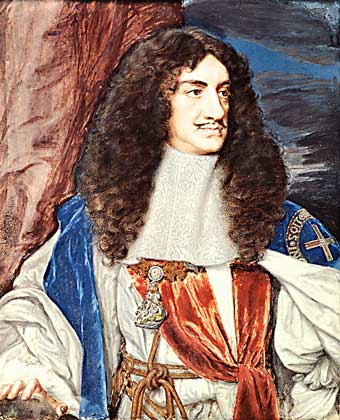 Charles II entering London after the restoration of the monarchy in 1660, undated hand-coloured …
Charles II entering London after the restoration of the monarchy in 1660, undated hand-coloured …
Конвенция провозгласила восстановление король и лордов распущена армия, установленным фиксированным доходом для короля, поддерживая парламентских инноваций акцизного налога, и вернулся к короне и епископы их конфискованные поместья. Но она не сделала никакого прогресса на религиозные поселения. Несмотря Чарльз обещание ограниченной веротерпимости и его желание принять пресвитериан в Англиканской раза, как указано в Вустере Дом декларации (1660), энтузиастов и слева и справа, крушение каждый компромисс.
Он остался Кавалер парламента (1661-79), чтобы сделать трудный выбор, и продемонстрировать, что одним из изменений, которые пережили революции был независимости парламента. Несмотря на Чарльза, желание относиться к его отца противников снисходительно и найти широкий церкви поселка, Кавалер парламент стремился установить жесткую Англиканской православия. Он начал альянса между squire and parson, который должен был доминировать английский местного общества на протяжении многих столетий. Епископы были возвращены в парламент, новый молитвенник было разрешено, а репрессивные акты были приняты, чтобы заставить соответствия. Наложение клятвы верности и непротивление корону и клятву признавая короля, превосходство в церкви, ко всем членам местного самоуправления в Corporation Act (1661 г.), а затем на духовенства в Закон Единообразия (1662 г.) привела к массовому очистить должностных лиц. Градоначальники, были выведены из их мест, и почти одна пятая часть всех священнослужителей были лишены средств к существованию. Власть в населенных пунктах, был теперь твердо в руках шляхты. В Conventicle Акта(1664) отстранено Нонконформисты (Раскольников) от проведения отдельных церковных служб, и Пять миль Акта (1665) запрещенные раскулаченных министры, даже не Посещая их бывшей паствы.
Эта программа репрессивных религиозное законодательство был первый из многих упущенных возможностей для удаления причины, лежащие в основе политического недовольства. Хотя и религиозных диссидентов, были не большой процент населения, их лечение видят призрак постоянно делится местных общин и потенциально произвольная власть. Это законодательства (the Clarendon Код) правила, связанные с именем лорда-канцлера Кларендон, ибо он, как и король, осознала опасность религиозных репрессий и попытался смягчить его последствия. Действительно, в центральном правительстве король опирался на людей различных политических взглядов и религиозных убеждений. Кларендон, кто жил король в изгнании, был его главный политический советник, и брат Чарльз Джеймс, герцог йоркский (позже Джеймс II), был его ближайшим доверенным лицом и было поручено витал пост лорда-адмирала. Монк, которые были выполнены реставрационные возможно, был поднят до герцог Albemarle и продолжал проводить военную власть над малой постоянной армии, что, впервые в английской истории, царь поддерживал.
Charles II arrived in London on the 30th birthday of what had already been a remarkably eventful life. He came of age in Europe, a child of diplomatic intrigues, broken promises, and unfulfilled hopes. By necessity he had developed a thick skin and a shrewd political realism. This was displayed in the Declaration of Breda (1660), in which Charles offered something to everyone in his terms for resuming government. A general pardon would be issued, a tolerant religious settlement would be sought, and security for private property would be assured. Never a man for details, Charles left the specifics to the Convention Parliament (1660), which was composed of members of the competing religious and political parties that contended for power amid the rubble of the Commonwealth.
The Convention declared the restoration of the king and the lords, disbanded the army, established a fixed income for the king by maintaining the parliamentary innovation of the excise tax, and returned to the crown and the bishops their confiscated estates. But it made no headway on a religious settlement. Despite Charles's promise of a limited toleration and his desire to accept Presbyterians into the Anglican fold as detailed in the Worcester House Declaration (1660), enthusiasts from both left and right wrecked every compromise.
It was left to the Cavalier Parliament (1661–79) to make the hard choices and to demonstrate that one of the changes that had survived the revolution was the independence of Parliament. Despite Charles's desire to treat his father's adversaries leniently and to find a broad church settlement, the Cavalier Parliament sought to establish a rigid Anglican orthodoxy. It began the alliance between squire and parson that was to dominate English local society for centuries. The bishops were returned to Parliament, a new prayer book was authorized, and repressive acts were passed to compel conformity. The imposition of oaths of allegiance and nonresistance to the crown and an oath recognizing the king's supremacy in the church upon all members of local government in the Corporation Act (1661) and then upon the clergy in the Act of Uniformity (1662) led to a massive purge of officeholders. Town governors were put out of their places, and nearly one-fifth of all clergymen were deprived of their livings. Authority in the localities was now firmly in the hands of the gentry. The Conventicle Act(1664) barred Nonconformists (Dissenters) from holding separate church services, and the Five Mile Act (1665) prohibited dispossessed ministers from even visiting their former congregations.
This program of repressive religious legislation was the first of many missed opportunities to remove the underlying causes of political discontent. Though religious dissenters were not a large percentage of the population, their treatment raised the spectre of permanently divided local communities and of potentially arbitrary government. This legislation (the Clarendon Code) is inappropriately associated with the name of Lord Chancellor Clarendon, for he, as well as the king, realized the dangers of religious repression and attempted to soften its effects. Indeed, in central government the king relied upon men of diverse political backgrounds and religious beliefs. Clarendon, who had lived with the king in exile, was his chief political adviser, and Charles's brother James, duke of York (later James II), was his closest confidant and was entrusted with the vital post of lord admiral. Monck, who had made the restoration possible, was raised to duke of Albemarle and continued to hold military authority over the small standing army that, for the first time in English history, the king maintained.